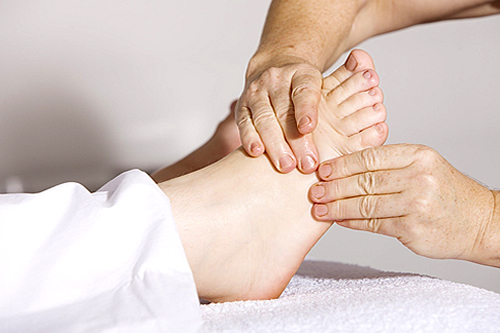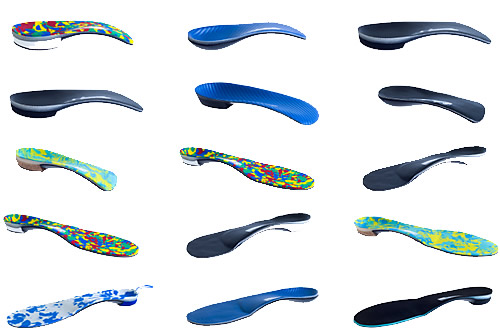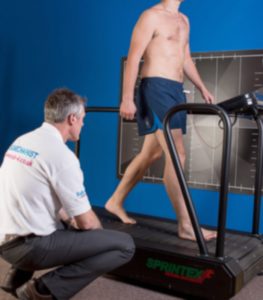What is Plantar fasciitis
 Plantar fasciitis is a common foot condition that affects the plantar fascia, a thick band of tissue that runs across the bottom of your foot, connecting your heel bone to your toes. This condition is characterized by inflammation, irritation, or tearing of the plantar fascia, leading to intense heel pain and discomfort. It is one of the most prevalent causes of heel pain, especially among adults.
Plantar fasciitis is a common foot condition that affects the plantar fascia, a thick band of tissue that runs across the bottom of your foot, connecting your heel bone to your toes. This condition is characterized by inflammation, irritation, or tearing of the plantar fascia, leading to intense heel pain and discomfort. It is one of the most prevalent causes of heel pain, especially among adults.
What are Causes of Plantar fasciitis
The exact cause of plantar fasciitis is often multifactorial. However, it is commonly associated with excessive strain on the plantar fascia, leading to small tears and inflammation. Some common factors that contribute to the development of plantar fasciitis include:
Overuse or High-Impact Activities: Repetitive stress on the feet, often seen in activities like running, dancing, or long periods of standing, can contribute to plantar fasciitis.
Improper Footwear: Wearing shoes with inadequate support or poor cushioning can strain the plantar fascia and increase the risk of developing the condition.
Biomechanical Issues: Abnormal foot mechanics, such as flat feet or high arches, can alter the distribution of weight on the feet, putting extra stress on the plantar fascia.
Age and Weight: Plantar fasciitis is more common in middle-aged individuals and those who are overweight, as excess weight can place additional strain on the foot.
Symptoms of Plantar fasciitis
The hallmark symptom of plantar fasciitis is sharp heel pain, typically experienced when taking the first steps in the morning or after prolonged periods of rest. The pain may subside with activity but can return after prolonged standing or walking. In some cases, the pain may radiate along the bottom of the foot.
Medical treatment Plantar fasciitis:
Rest and Ice: Resting the affected foot and applying ice can help reduce inflammation and alleviate pain.
Stretching Exercises: Gentle stretching exercises for the Achilles tendon and the plantar fascia can improve flexibility and reduce tension.
Orthotic Inserts: Custom or over-the-counter shoe inserts can provide additional support and cushioning, helping to alleviate strain on the plantar fascia.
Proper Footwear: Choosing supportive and well-cushioned shoes with a good arch can contribute to the overall management of plantar fasciitis.
Physical Therapy: In some cases, physical therapy may be recommended to strengthen the muscles in the foot and improve biomechanics.
In severe cases, when conservative measures fail, more advanced treatments such as corticosteroid injections or surgery may be considered. However, these options are typically reserved for refractory cases.
Understanding the causes, symptoms, and treatment options for plantar fasciitis is crucial for managing and preventing this common foot condition. If you experience persistent heel pain, consulting with a healthcare professional is essential for an accurate diagnosis and appropriate management.
Tips for Plantar fasciitis exercise
Plantar fasciitis, a condition causing heel pain due to inflammation of the plantar fascia, can significantly impact daily activities. Incorporating specific exercises into your routine can help alleviate symptoms and promote healing. Here are some useful tips for plantar fasciitis exercises:
- Stretching Exercises:
- Calf Stretches: Stretching the calf muscles reduces tension on the Achilles tendon and the plantar fascia. Stand facing a wall, place your hands on it, and step one foot back, keeping the knee straight. Bend the front knee while keeping the back heel on the ground. Hold for 15-30 seconds and switch sides.
- Towel Stretch: Sit on the floor with your legs stretched out. Loop a towel around the ball of your foot and gently pull it towards you, keeping the knee straight. Hold for 15-30 seconds, feeling the stretch along the bottom of your foot.
- Strengthening Exercises:
- Marble Pickup: Use your toes to pick up marbles or small objects from the floor, strengthening the muscles in the feet.
- Towel Scrunches: Place a towel on the floor and use your toes to scrunch it towards you. This exercise helps improve strength in the arch of the foot.
- Calf Raises:
- Perform calf raises by standing on a flat surface and lifting your heels off the ground. This exercise strengthens the calf muscles and supports the plantar fascia.
- Ice Massage:
- Freeze a water bottle and roll it under your foot for 10-15 minutes. This not only provides a massage effect but also helps reduce inflammation.
- Orthotic Inserts:
- Consider using orthotic inserts in your shoes to provide additional support and cushioning during exercises and daily activities.
- Low-Impact Activities:
- Opt for low-impact exercises such as swimming or cycling to maintain cardiovascular fitness without placing excessive strain on the plantar fascia.
- Consistency is Key:
- Perform these exercises regularly and consistently. Consistency is crucial for improving flexibility and strength, which can aid in the recovery process.
Before starting any exercise regimen, it’s essential to consult with a healthcare professional or a physical therapist to ensure the chosen exercises are suitable for your specific condition. Additionally, if you experience increased pain during or after exercises, it’s advisable to modify or discontinue them and seek professional guidance. By incorporating these tips into your routine, you can actively participate in managing plantar fasciitis and promoting a healthier, pain-free lifestyle.
How Inserts for Plantar fasciitis Work:

- Arch Support:
- Inserts for plantar fasciitis typically incorporate enhanced arch support. This feature helps distribute pressure evenly across the foot, reducing strain on the plantar fascia. By maintaining the natural alignment of the foot, arch support minimizes the stress on the inflamed tissue.
- Cushioning:
- The heel area of these inserts is often equipped with extra cushioning. This helps absorb shock during walking or standing, providing relief to the sensitive heel area affected by plantar fasciitis. The cushioning also assists in minimizing the impact on the plantar fascia, reducing discomfort.
- Improved Alignment:
- Inserts can help correct abnormal foot mechanics, such as overpronation or supination, which may contribute to plantar fasciitis. By aligning the foot properly, these inserts promote a more efficient gait, reducing strain on the plantar fascia.
- Pressure Redistribution:
- Plantar fasciitis often results from excessive pressure on specific areas of the foot. Orthotic inserts help redistribute this pressure, preventing excessive stress on the plantar fascia. This redistribution assists in maintaining a balanced and supportive environment for the foot.
- Shock Absorption:
- Walking and other weight-bearing activities generate shock that travels through the feet. Inserts with shock-absorbing properties help dampen this impact, providing a cushioned and supportive surface for the foot. This is particularly beneficial for individuals with plantar fasciitis, as it reduces the strain on the inflamed tissue.
Choosing the Right Inserts:
- Custom vs. Over-the-Counter:
- While over-the-counter inserts can be beneficial, custom-made orthotics, molded to the specific contours of an individual’s foot, provide a more personalized solution. A healthcare professional can help determine the most appropriate option.
- Material and Design:
- Inserts come in various materials and designs. Some are geared towards specific activities, such as running or work shoes. Choosing the right material and design ensures optimal comfort and support for the individual’s lifestyle.
Orthotic inserts are a valuable component of a comprehensive approach to managing plantar fasciitis. When used in conjunction with other treatments, such as stretching exercises and proper footwear, these inserts contribute significantly to relieving pain, promoting healing, and improving overall foot function.
How to cure Plantar fasciitis in one week
Curing plantar fasciitis in one week is an ambitious goal, as this condition often requires consistent and prolonged efforts for effective management. While complete resolution in such a short timeframe may not be realistic, there are steps you can take to alleviate symptoms and promote healing safely.
Safety Information:
- Consult a Professional:
- Before attempting any rapid treatment, consult with a healthcare professional, preferably a podiatrist or orthopedic specialist. They can provide an accurate diagnosis, rule out other potential issues, and offer tailored advice based on your specific condition.
- Rest and Ice:
- Prioritize rest and apply ice to the affected heel. Resting helps reduce inflammation, while ice can alleviate pain. However, excessive use of ice can cause tissue damage, so it’s essential to follow recommended guidelines.
- Stretching Exercises:
- Perform gentle stretching exercises for the calf muscles, Achilles tendon, and plantar fascia. These exercises can improve flexibility and alleviate tension. However, aggressive stretching may exacerbate the condition, so it’s crucial to avoid overstretching.
- Foot Elevation:
- Elevating the foot when resting can aid in reducing swelling and promoting circulation. Use a pillow or cushion to keep the affected foot slightly elevated while sitting or lying down.
- Proper Footwear:
- Wear supportive shoes with adequate cushioning and arch support. Avoid flat shoes or those with insufficient support, as they can contribute to plantar fasciitis.
- Over-the-Counter Inserts:
- Consider using over-the-counter orthotic inserts for added support. However, custom-made inserts may be more effective, and it’s advisable to seek professional guidance for the most suitable option.
- Avoid High-Impact Activities:
- Minimize or avoid high-impact activities such as running or jumping during the healing process. Engage in low-impact exercises like swimming or cycling.
While these measures can contribute to symptom relief, a one-week timeframe for a complete cure may not be feasible. Consistency and long-term adherence to recommended treatments, including physical therapy if needed, are crucial for effectively managing and eventually resolving plantar fasciitis. Always prioritize safety and seek professional guidance for an individualized treatment plan.
Effective Plantar Fasciitis Stretches

Plantar fasciitis, a common cause of heel pain, can significantly impact daily activities. Incorporating targeted stretches into your routine can be instrumental in managing symptoms and promoting the healing of the plantar fascia. Here’s some advice on effective plantar fasciitis stretches:
1. Calf Stretches: Wall Stretch
- Stand facing a wall with your hands pressed against it.
- Place one foot behind the other, keeping both heels on the ground.
- Gently bend the front knee while keeping the back leg straight.
- Hold the stretch for 15-30 seconds, feeling the stretch in your calf and the bottom of your foot.
- Repeat on the other leg.
2. Towel Stretch:
- Sit on the floor with your legs stretched out in front of you.
- Loop a towel around the ball of your foot, holding each end with your hands.
- Gently pull the towel towards you, keeping your knee straight.
- Hold the stretch for 15-30 seconds, feeling the stretch along the bottom of your foot.
- Repeat on the other foot.
3. Plantar Fascia Stretch:
- Sit on a chair and cross one ankle over the opposite knee.
- Using your hand, gently pull your toes back towards your shin until you feel a stretch in the bottom of your foot.
- Hold for 15-30 seconds and switch to the other foot.
4. Toe Stretch:
- Sit or stand and cross one leg over the other.
- Hold the toes of the crossed leg and gently pull them back towards your shin.
- Hold for 15-30 seconds, feeling the stretch in the bottom of your foot.
- Switch to the other foot.
Tips for Safe Stretching:
- Gentle Progression:
- Start with mild stretches and gradually increase the intensity as your flexibility improves. Avoid aggressive stretching, as it can worsen the condition.
- Consistency is Key:
- Perform these stretches regularly, especially before getting out of bed in the morning or after long periods of rest. Consistency is crucial for long-term relief.
- Listen to Your Body:
- If you experience increased pain during a stretch, modify the intensity or discontinue the exercise. Consult with a healthcare professional if pain persists.
- Combine with Other Treatments:
- Stretches work best when combined with other treatments like proper footwear, orthotic inserts, and rest.
Incorporating these plantar fasciitis stretches into your daily routine can contribute to symptom relief and support the healing process. However, always consult with a healthcare professional for personalized advice and to ensure that these stretches are suitable for your specific condition.
Plantar fasciitis shoes UK
Choosing the right footwear is crucial for managing plantar fasciitis, a condition characterized by inflammation of the plantar fascia and intense heel pain. The right shoes can provide essential support and alleviate strain on the affected area. Here’s a guide on selecting plantar fasciitis shoes and seeking advice:
Characteristics of Plantar Fasciitis Shoes:
- Arch Support:
- Look for shoes with excellent arch support to reduce stress on the plantar fascia. Proper arch support helps maintain the foot’s natural alignment, minimizing strain on the inflamed tissue.
- Cushioning:
- Opt for shoes with adequate cushioning, especially in the heel area. Cushioned soles absorb shock during walking, reducing the impact on the heel and promoting comfort.
- Heel Support:
- A firm heel counter (the back part of the shoe surrounding the heel) provides stability and helps control excessive foot movement, preventing further irritation to the plantar fascia.
- Flexible Sole:
- While the sole should be supportive, it should also be flexible at the ball of the foot. This flexibility aids in a more natural gait and reduces strain on the plantar fascia.
- Wide Toe Box:
- Shoes with a wide toe box allow for proper toe splay, reducing pressure on the front of the foot and enhancing overall comfort.
Seeking Advice on Plantar Fasciitis Shoes:
- Consult a Podiatrist:
- A podiatrist or orthopedic specialist can assess your specific condition and provide personalized recommendations for suitable footwear.
- Visit a Specialty Shoe Store:
- Specialty shoe stores often have knowledgeable staff who can assess your foot type and recommend shoes tailored to your needs. They may also offer a variety of brands designed for plantar fasciitis.
- Consider Custom Orthotics:
- Custom orthotic insoles, prescribed by a healthcare professional, can be inserted into your shoes for additional support. These can address specific biomechanical issues contributing to plantar fasciitis.
- Read Reviews:
- Online reviews and testimonials from individuals with plantar fasciitis can provide insights into the effectiveness of certain shoe brands and models. Look for reviews that highlight support and comfort.
- Replace Worn-Out Shoes:
- Regularly assess the condition of your shoes, and replace them when they show signs of wear. Worn-out shoes may lose their supportive features, potentially exacerbating plantar fasciitis symptoms.
Investing in the right plantar fasciitis shoes and seeking professional advice can significantly contribute to symptom relief and overall foot health. Prioritize comfort, support, and proper fit to ensure your footwear supports your efforts in managing plantar fasciitis effectively.
WE OFFER FREE 30 MINUTE ASSESSMENT TO TRY TO ESTABLISH THE CAUSE OF YOUR PAIN AND DISCUSS TREATMENT (IF ANY)
Read more about Sub-4 Orthotics Here
Good shoes for plantar fasciitis and the best shoes to help plantar fasciitis recovery
Choosing the right shoes is crucial for managing plantar fasciitis and promoting overall foot health. The best shoes for plantar fasciitis provide proper support, cushioning, and stability. Additionally, good shoes in general should address individual foot characteristics and lifestyle needs.
Best Shoes for Plantar Fasciitis:
- New Balance 990v5:
- Known for its excellent arch support and cushioning, the New Balance 990v5 is a popular choice for individuals with plantar fasciitis. The shoe provides stability and a comfortable fit, making it suitable for daily activities.
- Brooks Adrenaline GTS 21:
- This running shoe offers reliable support and cushioning, making it suitable for those with plantar fasciitis who engage in physical activities like jogging. It features a supportive midsole that helps control pronation.
- Saucony Kinvara 12:
- With a lightweight design and ample cushioning, the Saucony Kinvara 12 is another option for plantar fasciitis sufferers. It provides a good balance of support and flexibility.
- ASICS Gel Kayano 28:
- ASICS Gel Kayano 28 is praised for its stability and shock absorption. It offers ample cushioning and is designed to support individuals with overpronation, which is common in plantar fasciitis cases.
Characteristics of Good Shoes in General:
- Arch Support:
- Proper arch support is crucial for maintaining the foot’s natural alignment and preventing excessive strain on the plantar fascia.
- Cushioning:
- Shoes with adequate cushioning help absorb shock during walking or running, reducing the impact on the heel and promoting overall comfort.
- Stability:
- A stable shoe, particularly in the heel and midfoot areas, helps control foot movement and prevents overpronation or supination.
- Roomy Toe Box:
- Shoes with a wide and roomy toe box allow for proper toe splay, preventing crowding and reducing pressure on the front of the foot.
- Breathability:
- Good shoes should have breathable materials to prevent excessive moisture, which can contribute to discomfort and foot issues.
- Proper Fit:
- Shoes should fit well, providing adequate length and width. Ill-fitting shoes can lead to various foot problems, including plantar fasciitis.
- Quality Materials:
- Durable and high-quality materials contribute to the longevity of the shoes. Well-constructed footwear is an investment in foot health.
When selecting shoes, consider your individual foot structure, gait, and activity level. It’s advisable to consult with a podiatrist or footwear specialist for personalized recommendations. Remember that the best shoes not only alleviate plantar fasciitis symptoms but also contribute to overall foot comfort and health.
Plantar fasciitis insoles
Plantar fasciitis insoles, also known as orthotic insoles or inserts, are specially designed footbeds that provide additional support, cushioning, and alignment for individuals suffering from plantar fasciitis. These insoles aim to reduce strain on the plantar fascia, alleviate pain, and promote better foot function. While numerous options are available, the best plantar fasciitis insoles in the UK cater to individual needs, offering comfort and support for daily activities.
Characteristics of Plantar Fasciitis Insoles:
- Arch Support:
- The primary feature of these insoles is enhanced arch support. Proper support helps distribute weight more evenly across the foot, reducing stress on the plantar fascia.
- Cushioning:
- Insoles with ample cushioning, particularly in the heel and arch areas, provide shock absorption, minimizing the impact on the foot and reducing pain associated with plantar fasciitis.
- Firmness and Stability:
- A balance between firmness and flexibility is essential. The insoles should be supportive enough to maintain proper foot alignment and stability while allowing for a natural gait.
- Contoured Shape:
- Contoured insoles that mimic the natural shape of the foot offer better support and comfort. They help prevent overpronation or supination, common factors contributing to plantar fasciitis.
- Moisture-Wicking Material:
- Insoles made from breathable and moisture-wicking materials help keep the feet dry and comfortable, reducing the risk of irritation and friction.
- Adaptability to Different Shoes:
- The best insoles are versatile and can be used in various types of shoes, including athletic shoes, casual shoes, and work shoes.
Best Plantar Fasciitis Insoles in the UK
Insoles are generally referred to as Orthotics and in general, are shoe inserts designed to provide support, improve foot and ankle alignment, and alleviate discomfort associated with various foot conditions, including plantar fasciitis.
Sub-4 Quality:
- Superior Material:
- High-quality orthotics are often made from durable materials that offer good support and cushioning. Common materials include foam, gel, or custom-molded materials.
- Arch Support:
- Effective orthotics should provide adequate arch support to help distribute weight evenly across the foot, reducing stress on the plantar fascia.
- Heel Cup:
- A well-designed heel cup ensures proper heel stabilization and alignment. This is crucial for individuals with plantar fasciitis and other heel-related issues.
- Versatility:
- Quality orthotics should be versatile enough to fit into various types of shoes, from athletic shoes to dress shoes, to accommodate different lifestyles.
Plantar fasciitis so bad I can t walk
If you’re experiencing severe plantar fasciitis to the extent that walking becomes excruciating, it’s crucial to seek immediate help to address the pain and prevent further complications. Ignoring severe plantar fasciitis can lead to long-term issues and significantly impact your quality of life.
Seek Professional Medical Attention:
- Podiatrist or Orthopedic Specialist:
- Schedule an appointment with a podiatrist or orthopedic specialist. These healthcare professionals specialize in foot and ankle conditions and can provide a thorough examination to diagnose the severity of your plantar fasciitis.
- Urgent Care or Emergency Room:
- If the pain is unbearable and you are unable to walk, consider visiting urgent care or the emergency room for immediate assistance. They can provide pain management and diagnostic services promptly.
Immediate Self-Care Measures:
- Rest:
- Minimize weight-bearing activities and allow your foot to rest. Avoid walking or standing for prolonged periods.
- Ice:
- Apply ice to the affected heel for 15-20 minutes every 2-3 hours. This can help reduce inflammation and numb the area, providing temporary relief.
- Elevate:
- Elevate your leg to reduce swelling. Prop your foot up on pillows when lying down.
Avoid Self-Diagnosis and Treatment:
- Over-the-Counter Medications:
- While over-the-counter pain relievers may offer temporary relief, they don’t address the root cause. Consult with a healthcare professional before relying solely on medications.
- Home Remedies:
- While stretching exercises and orthotic inserts can be beneficial, it’s crucial to get a professional assessment before attempting any self-prescribed treatments.
Dont suffer with pain – Call Sub-4 on 01782 551698
If your plantar fasciitis is so severe that walking is nearly impossible, do not delay seeking help. Immediate attention from a healthcare professional is essential for accurate diagnosis and effective treatment. Ignoring the pain may lead to further damage and prolonged recovery.
Your mobility and overall well-being are at stake, and getting professional help promptly can make a significant difference in your recovery. Remember, there are various treatment options available, ranging from conservative measures to more advanced interventions, depending on the severity of your condition. Prioritize your health and take the necessary steps to address severe plantar fasciitis as soon as possible.
The best solution is to book an appointment with a professional podiatrist in Stoke on Trent, Staffordshire who can help get top the root of your pain. Book Here
Visit Our Facebook page for more information Here
